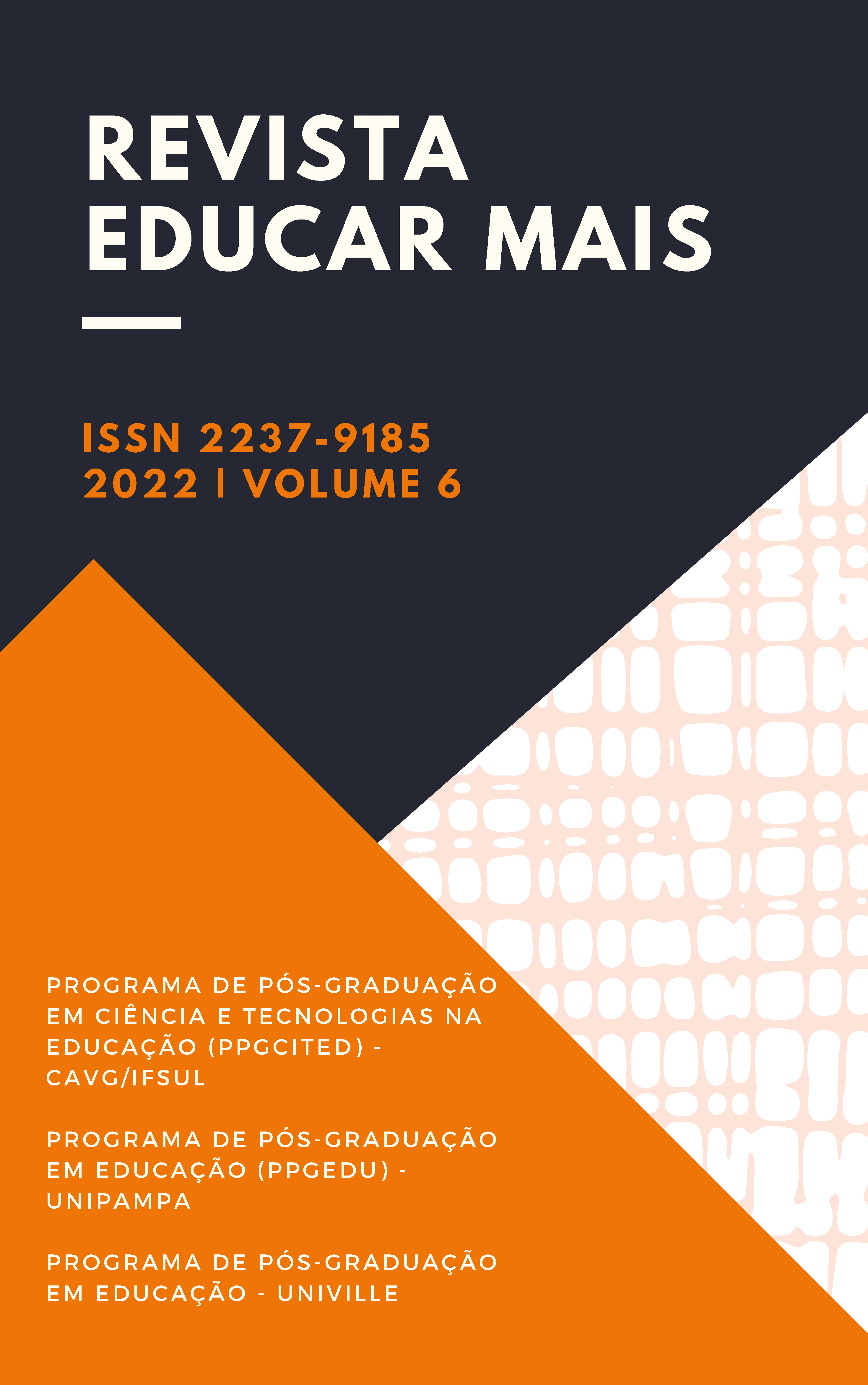Didactic sequence in the teaching of oblique launch with the help of a simulator PhET platform
DOI:
https://doi.org/10.15536/reducarmais.6.2022.2806Keywords:
Teacher training, Simulations, Continuous Training, Projectile MovementAbstract
The oblique movement happens from the launch of an object, in which the initial parameters are speed and angle in relation to the horizontal. Foreseeing the discussion of this content in basic education, a didactic sequence was proposed with students who are members of PIBID, so that a simulator of the PhET platform played the role of auxiliary resource in the development of activities. The previous analysis, carried out in the simulator, sought to analyze the number of attempts made to reach the target from the launch of an object. This target was reached after several attempts, and no student related the objective to the reach given by equations. Motion was discussed physically and mathematically and further analysis asked for the range of a rocket from given values for velocity and angle. The results showed that all students reached the value of reach, in which advances of learning are verified. These facts place the didactic sequence as a methodology capable of adding knowledge and simulations as potentializing agents in the educational process.
Downloads
References
DOLZ, J.; NOVERRAZ, M.; SCHNEUWLY, B. Sequências didáticas para o oral e a escrita: apresentação de um procedimento. In: SCHNEUWLY, B; DOLZ, J. Gêneros orais e escritos na escola. Tradução de Roxane Rojo e Glaís Sales Cordeiro. Campinas: Mercado das Letras, 2004. p. 95-128.
DOMINGOS, Rafael Brock; TEIXEIRA, Ricardo Roberto Plaza. Simulações de fenômenos da natureza no ensino de Física. RCT - Revista de Ciência e Tecnologia, v. 8, p. 1-15, 2022. Disponível em: https://revista.ufrr.br/rct/article/view/7201. Acesso em: 28 mar. 2022.
LAVOR, Otávio Paulino; OLIVEIRA, Elrismar Auxiliadora Gomes. Grandezas proporcionais: sequência didática na formação inicial de professores. REAMEC - Rede Amazônica de Educação em Ciências e Matemática, v. 10, n. 1, e22014, 2022. Disponível em: https://periodicoscientificos.ufmt.br/ojs/index.php/reamec/article/view/13476. Acesso em: 28 mar. 2022.
MOREIRA, Marco Antonio. Desafios no ensino da física. Revista Brasileira de Ensino de Física, v. 43, e20200451, 2021. Supl. 1. Disponível em: https://www.scielo.br/j/rbef/a/xpwKp5WfMJsfCRNFCxFhqLy/?format=pdf&lang=pt. Acesso em: 28 mar. 2022.
MOURA, Patrícia de Souza; RAMOS, Maria do Socorro Ferreira; LAVOR, Otávio Paulino. Investigando o ensino de trigonometria através da interdisciplinaridade com um simulador da plataforma PhET. REAMEC - Rede Amazônica de Educação em Ciências e Matemática, v. 8, n. 3, p. 573-591, 2020. Disponível em: https://periodicoscientificos.ufmt.br/ojs/index.php/reamec/article/view/10784. Acesso em: 26 mar. 2022.
OLIVEIRA, Cícera Janete Alves de; LAVOR, Otávio Paulino. Sequência didática para o ensino e aprendizagem de juros compostos com o software Geogebra. Boletim Cearense de Educação e História da Matemática, v. 9, n. 25, p. 96–110, 2022. Disponível em: https://revistas.uece.br/index.php/BOCEHM/article/view/7400. Acesso em: 28 mar. 2022.
RAMOS, Maria do Socorro Ferreira; MOURA, Patricia de Souza; LAVOR, Otávio Paulino. Educação financeira: Sequência didática com o aplicativo “Minhas Economias”. Revista de Investigação e Divulgação em Educação Matemática, v. 4, n. 1, p. 1-19, 2020. Disponível em: https://periodicos.ufjf.br/index.php/ridema/article/view/32047. Acesso em: 28 mar. 2022.
UGALDE, Maria Cecília Pereira; ROWEDER, Charlys. Sequência didática: uma proposta metodológica de ensino-aprendizagem. Educitec - Revista de Estudos e Pesquisas sobre Ensino Tecnológico, v. 6, e99220, 2020. Edição especial. Disponível em: https://sistemascmc.ifam.edu.br/educitec/index.php/educitec/article/view/992. Acesso em: 30 mar. 2022.
ZAMORA, Walder Sánchez. La simulación Phet en el aprendizaje de las ciencias naturales y las matemáticas. Revista Académica Arjé, v. 4, n. 1, p. 81-95, 2021. Disponível em: https://revistas.utn.ac.cr/index.php/arje/article/view/350. Acesso em: 28 mar. 2022.
Downloads
Published
How to Cite
Issue
Section
License
Copyright (c) 2022 Otávio Paulino Lavor, Elrismar Auxiliadora Gomes Oliveira

This work is licensed under a Creative Commons Attribution-NonCommercial 4.0 International License.
DECLARATION OF RESPONSIBILITY: I hereby certify that I partially or fully participated in the conception of the work, that I did not hide any links or financial agreements between the authors and companies that may be interested in this article publication. I certify that the text is original and that the work, partially or fully, or any other work with a substantially similar content written by me, was not sent to any other journal and it will not be send while my submission is being considered by Revista Educar Mais, whether in printed or electronic format.
The author responsible for the submission represents all the authors of the manuscript and, when sending the article to the journal, guarantees s/he has obtained the permission to do so, as well as s/he guarantees the article does not infringe upon anyone’s copyright nor violate any proprietary rights. The journal is not responsible for the opinions expressed.
Revista Educar Mais is Open Access, does not charge any fees, whether for submission or article processing. The journal adopts Budapest Open Access Initiative (BOAI)’s definition, i.e., any users are permitted to read, download, copy, distribute, print, search and link to the full texts of these articles.
All the articles are published under the Creative Commons Atribuição-NãoComercial 4.0 Internacional license. The authors keep the copyright of their production. That way, they must be contacted directly if there is any interest in commercial use of their work.
















